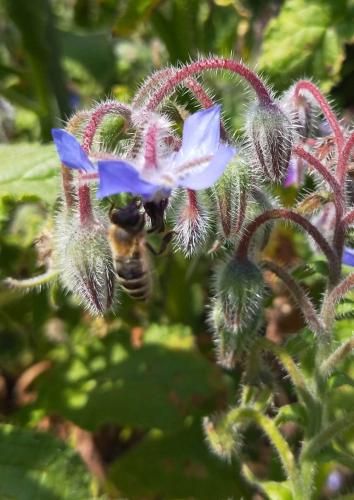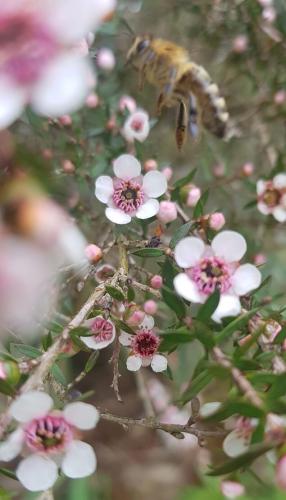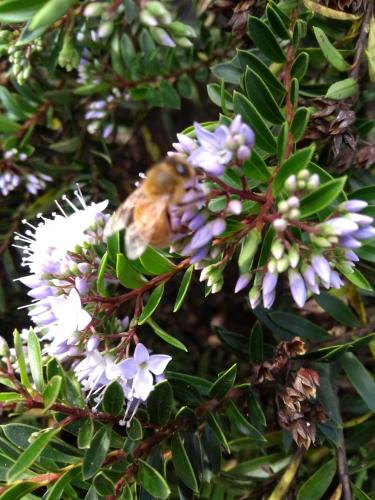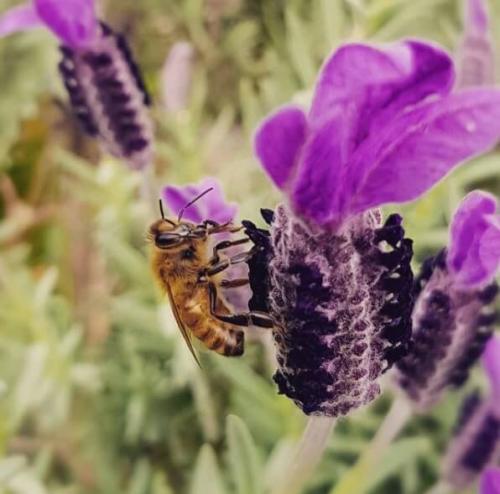

Nectar & Pollen Calendar
Information source: Steve Benham from Franklin Beekeepers Club.
Click here to view our Nectar & Pollen Calendar (PDF)
Nectar:
- It’s the raw ingredient of honey.
- It’s a sugar solution (usually sucrose, glucose, fructose and sometimes maltose) in water with amino acids, minerals, essential oils and organic acids, which is secreted by the nectarines situated at the base of the stamens.
- It’s produced by flowers to lure pollinators to flowers for pollination and eventual fertilisation (ensuring reproduction of the species). Pollination, especially for many food crops is essential for successful cropping.
- Bees seem to prefer nectar with equal quantities of glucose, fructose and sucrose.
- Some plants e.g. citrus reliably produce abundant nectar despite environmental conditions.
- Once flowers have been pollinated, they produce less nectar e.g. cucumber flowers only produce nectar on their first day of opening
- Flower gender influence nectar production e.g. banana male flowers secrete more nectar than female flowers. Willow are dioecious which means that male and female flowers occur on separate plants. Male flowers have nectar and pollen whereas female flowers have only nectar.
Pollen:
- It’s the reproductive part of the flower.
- It’s the male germplasm of plants and is a source of proteins, minerals, lipids and trace elements necessary for bee growth.
- It’s vital for the production of royal jelly by worker bees used to feed the queen, larvae and young adults.
- It contains proteins, carbohydrates, lipids, amino acids, water, vitamins (A, B1, B2, B3, B5, B6, B12, C, D, E, P), minerals (calcium, copper, iron, phosphorus, potassium, sodium), folic acid and bioflavonoids.
- Bees will usually only work one type of flower on each trip so as not to mix pollen types.
- Bees target plants with high quality pollen and can differentiate between high and low value pollen.
- Bees scramble all over a flower to collect pollen then brushes the pollen off its hairy body with its legs and collects it in its pollen basket (on its legs) known as a corbiculare.
- Bees bring pollen pellets back to the hive to drop in a cell, mix with nectar and saliva, compact and cap with honey and wax. Capped pollen is known as bee bread
- Bees increase their consumption of pollen when brood rearing i.e. autumn, late winter and early spring.
What affects nectar & pollen production:
- Air temperature.
- Soil moisture.
- Soil fertility.
- Sunlight levels.
- Plant processes such as photosynthesis, respiration, growth and flower age.
- Herbicides. Chemicals may have a negative impact on soil quality which in turn affects nectar quality (bees only visit flowers with high-quality nectar).
The 9 plant families with outstanding nectar production:
- Rosaceae: all stone (cherry is best) and pip fruits, blackberry, hawthorn.
- Fabaceae: clover, gorse, false acacia, mimosa.
- Lamiaceae: rosemary, lavender, sage and other salvias, thyme, mint, bee balm, basil, catmint.
- Scrophulariaceae: koromiko (Hebe species and cvs), penstemons, veronicas.
- Brassicaceae: brassicas, rocket.
- Asteraceae: michaelmas daisy dandelion, sunflower, dahlias, heleniums, cosmos, echinacea, zinnia.
- Myrtaceae: eucalypts, pohutukawa, rata, bottlebrush, manuka, kanuka.
- Rutaceae: citrus.
- Ericaceae: heather.
The 9 plants producing masses of pollen:
- Willow
- Hazel
- Alder
- Oak
- Pine
- Privet
- Gorse
- Ivy
- Houpara
The flowers bees love:
- Colours in their visual range: blue (like lavender, borage, rosemary, echium, forget-me-not), yellow, green and ultraviolet.
- Single flowers (not double flowers i.e. masses of petals) with easily accessible nectaries (for nectar) and stamens (for pollen).
Top 12 plants to plant
- Australian bottlebrush (Callistemon linearis, C. citrinus)
- Borage (Borago officinalis)
- Cabbage tree (Cordyline australis)
- Cuphea hyssopifolia
- Eupatorium ‘Gateway’
- Grevillea lanigera ‘Mt. Tamboritha’
- Hebe ‘Wiri Charm’
- Manuka (Leptospermum scoparium)
- Phacelia tanacetifolia
- Rosemary (Rosmarinus officinalis + cvs)
- Salvia apiana, S. fallax and other spp.
- Thyme (Thymus vulgaris, T, serpyllum)
Plants to avoid planting (produce toxic nectar):
- Camellia reticulata
- Foxglove (Digitalis purpurea)
- Oleander (Nerium oleander)
- Rhododendron spp., cvs.
- Karaka (Corynocarpus laevigatus)
- Tree tutu (Coriaria arborea)


Photo credit: The Honey Bee Collective

Photo credit: Martyn Brown

Photo credit: The Honey Bee Collective


Photo credit: The Honey Bee Collective
